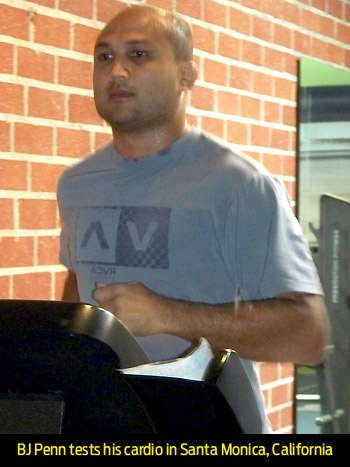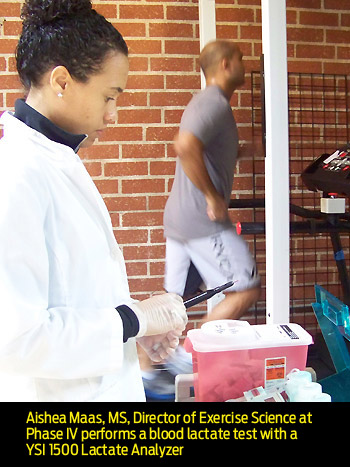28-Days-to-Lean Meal Plan
With the right plan and the right discipline, you can get seriously shredded in just 28 days.
Read article
On October 29th, future UFC Hall of Famer BJ Penn meets Nick Diaz in a welterweight match at UFC 137 in Las Vegas. On paper, the fighters are quite similar; both are Brazilian Jiu-Jitsu black belts who have adopted incredibly effective boxing-oriented styles of stand-up fighting. The glaring difference between the two is the size of their gas tank.
While Diaz has shown time and time again that he is one of the best-conditioned fighters in the sport, Penn, despite his power and technical brilliance, has tended to fade in the later rounds. Many fight pundits expect Penn to come on strong only to exhaust himself and eventually be overwhelmed by Diaz’ non-stop barrage of high-output punching.
One group of scientists isn’t buying that scenario that all
Penn has enlisted The Phase IV Performance Team in Santa Monica, Calif., to bring his training into the realm of cutting edge sports science. Owner and founder, physical therapist Robert Forster, who also owns Forster Physical Therapy, has worked with countless pro athletes and Olympic gold medalists in his 30 years of practice, including, Pete Sampras, Jackie Joyner-Kersee, Maria Sharapova, and NBA star Elton Brand.
“Conditioning will be critical for this fight against Diaz,” says Forster who competed in Division One NCAA wrestling and who continues to compete at the Masters level now. “We were hired to analyze the weaknesses in his fitness and create a scientific strength and conditioning program to not only increase stamina but bring his fitness to a peak for this fight.
“BJ needed to slow down his training as is common in this sport where everyone believes they need intense training all the time. This mentality creates over-trained fighters who feel the fatigue and then train some more in a vain in an attempt to get the their snap back. It’s an ill-advised approach that leads to lackluster performances.”
Overtraining has been a plague on MMA athletes since the very beginning, but current fads in sports conditioning have turned that problem into an epidemic. A preference for high intensity interval training and a disdain for longer less-intense bouts of cardio (what boxers refer to as “roadwork”,) has created a regimen for fighter that forces them to go from intense bouts of sparring to intense sessions of strength and conditioning. They quickly reach a point of diminishing returns.
 “We know from our work with Olympic sprinters that even anaerobic, explosive athletes, must build their endurance with aerobic fitness first to reach peak fitness later when it counts,” says Forster.
“We know from our work with Olympic sprinters that even anaerobic, explosive athletes, must build their endurance with aerobic fitness first to reach peak fitness later when it counts,” says Forster.
Phase IV Director of Exercise Science, Aishea Maas, MS, [pictured] showed Penn the heart rate zones he needed to train in order to lay down a foundation of increased aerobic capacity first before moving on to more intense workouts. This resulted in his ability to fight harder before burning out.
“Because of the constant, high intensity work he was doing, even when he exercised at low intensity, BJ was using his anaerobic system to make energy,” explains Maas. “The problem is that this system produces lactic acid as a natural by product and when enough lactic acid accumulates in the muscle cell, fatigue sets in. Secondly, anaerobic metabolism utilizes carbohydrate as an energy source and quickly exhausts the limited carbohydrate store.”
Training for longer durations at low intensities slowly retrained Penn’s system so he could fight intensely while relying less on his anaerobic system, and thus producing less lactic acid. And when he does go to his anaerobic system, his new and improved aerobic system will help his body clear the lactic acid and actually use it as an energy source. It also means he relies more on the nearly limitless energy of his fat stores thus sparing his precious carbohydrate reserves.
“It’s accepted science that more fighters need to understand,” says Maas.
After working with the former Lightweight and Welterweight UFC Champion, Forster, Maas and the Phase IV team are determined to shift the paradigm in MMA training to a more scientific approach that is built on a broader aerobic fitness foundation.
“Most people think it odd that a better aerobic base will assist athletes in anaerobic sports like wrestling and MMA ” says Forster. “In fact this is the approach of the Eastern European teams who now dominate international wrestling.”
Forster and his team, who are attending the fights in person this Saturday, are supremely confident in their athlete. In their minds, they have the two necessary factors that are instrumental in developing a superior athlete.
“We have a willing fighter and a scientific approach to exact these improvements, so we are optimistic that you will see a different BJ Penn come October 29th!”
Notifications